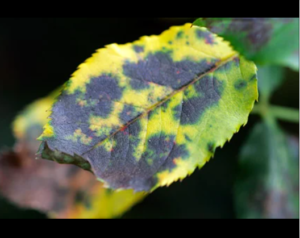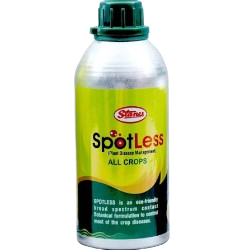Hello everyone, ln this article we will know about black spot and it’s important, factors like it’s introduction, identification, Couse of black spot, precaution and it’s treatment.
Introduction of black spot disease

In agriculture, A “black spot” often refers to a specific type of plant disease where dark, often sunken lesions appear on leaves, stems, or fruits. This condition can be caused by various pathogens, including fungi, bacteria, or viruses.
Read more: Sooty mold disease: Identification, Cause, Precaution And Treatment
These black spots can significantly impact crop yield and quality, making it essential for farmers to identify and manage these diseases through practices like crop rotation, using resistant varieties, and applying appropriate fungicides or bactericides.
Identification of black spot disease

Identifying black spot disease in plants involves observing specific symptoms and conducting diagnostic tests to confirm the presence of the pathogen.
- Dark, often round or irregularly shaped spots on leaves, stems, or fruits. The spots may have a necrotic center and can be surrounded by a yellow or chlorotic halo.
- Sunken or raised lesions may develop, and in some cases, the affected tissue might die and fall off.
Black spots may appear in clusters and can spread rapidly under favorable conditions (high humidity, warm temperatures). - Carefully examine the plant for characteristic symptoms, noting their size, shape, and location on the plant.
- Using a microscope, observe any fungal spores, bacterial cells, or viral particles in the lesions to identify the pathogen.
- For definitive diagnosis, send samples to a plant pathology lab for testing. Techniques like PCR (Polymerase Chain Reaction) can be used to detect specific pathogens.
Causes of black spot disease
Black spot disease in plants can be caused by various pathogens, each affecting plants differently. The primary causes include:
1. Fungal pathogens
- Alternaria spp:- Causes dark, sunken spots on leaves and fruits. Common in tomatoes and potatoes.
- Septoria spp:- Leads to small, dark spots with a yellow halo, affecting leaves and stems. Often seen in tomatoes and potatoes.
- Phyllosticta spp:- Results in black, circular spots with a characteristic halo, affecting various crops.
Also Read: Protein Biochemistry: Definition And Chemical Compositions
2. Bacterial Pathogens
- Xanthomonas spp:- Causes black spots and lesions on leaves and stems, often accompanied by a yellowing halo. Affects plants like cucumbers and peppers.
- Pseudomonas spp:- Can lead to dark, necrotic spots on foliage and fruits, contributing to various plant diseases.
3. Viral Pathogens
- Tobacco Mosaic Virus (TMV)- Causes dark, mottled spots on leaves, sometimes with a rough texture. Affects a range of plants including tomatoes and peppers.
- Cucumber Mosaic Virus (CMV)- Leads to dark spots and mottling on leaves and fruits, impacting a wide variety of crops.
Create favorable conditions for fungal and bacterial pathogens to thrive.
Can stress plants, making them more susceptible to infections.
Leads to poor air circulation, increasing humidity and promoting disease spread.
Precautions of blight spot
- Avoid planting the same crop in the same location each year to reduce pathogen buildup in the soil.
Ensure adequate spacing between plants to improve air circulation and reduce humidity, which helps prevent fungal and bacterial growth. - Remove and destroy infected plant debris and fallen leaves to prevent pathogen spread. Clean tools and equipment regularly.
- Use drip irrigation or water at the base of plants to keep foliage dry, as wet leaves can encourage disease development.
- If overhead irrigation is necessary, water early in the day to allow time for leaves to dry before nightfall.
Choose plant varieties that are resistant or tolerant to black spot disease, as these will have a better chance of surviving and thriving. - Apply fungicides and bactericides as per recommended schedules and guidelines to manage and prevent disease outbreaks. Ensure to follow proper application methods to avoid resistance development.
- Prune plants to improve airflow and reduce humidity around foliage.
Ensure well-draining soil to reduce conditions conducive to pathogen growth
Treatment of black spot disease

Treating black spot disease in plants involves a combination of cultural, chemical, and sometimes biological approaches.
Here’s a comprehensive strategy for managing and treating black spot:
- Remove and discard infected leaves, stems, or fruits to reduce the source of the disease.
Space plants adequately and prune them to improve airflow, which helps reduce humidity and the likelihood of fungal or bacterial growth. - Clean up fallen leaves and plant debris, and disinfect tools and equipment to minimize the risk of spreading the pathogen.
- Apply fungicides suitable for the specific pathogen causing black spot.
- Examples include: Chlorothalonil: Effective against a range of fungal pathogens.
- Azoxystrobin: Used for various fungal diseases.
- Copper-based Fungicides: Useful for both fungal and bacterial black spots.
- Bactericides: For bacterial black spot, use bactericides such as copper hydroxide or copper sulfate.
- Beneficial Microorganisms: Use biological control agents like:
- Trichoderma spp. Can suppress various fungal pathogens.
- Bacillus spp. Certain strains can help in controlling bacterial diseases.
- Bio fungicide: Products containing natural predators or antagonists of the pathogen.
- Choose plant varieties that are resistant or tolerant to black spot disease to reduce the incidence of the disease.
- Use drip irrigation or water at the base of plants to keep foliage dry. Avoid overhead watering.
Regularly check plants for early signs of black spot disease. Early detection allows for prompt intervention and can prevent widespread infections.
Conclusion of black spot disease
Black spot disease, caused by various pathogens, can severely impact plants.
Effective management requires early identification, preventive cultural practices, targeted chemical and biological treatments, use of resistant varieties, and proper environmental control.
Integrating these strategies helps in controlling the disease and maintaining plant health.
Frequent Asked Questions
1. What is the black spot?
Black spot is a plant disease characterized by dark, necrotic lesions on leaves, stems, or fruits, caused by pathogens like fungi, bacteria, or viruses. It can lead to reduced plant health and yield.
2. What are cause of black spot on?
Black spots on crops can be caused by:
Such as leaf spot or blight. Like bacterial spot. Certain insects can cause damage leading to dark spots. Imbalances can lead to spotting. Factors like drought or extreme temperatures.
3. What is black spot disease?
Black spot disease is a common fungal infection affecting plants. It’s caused by the fungus Symptoms include dark, circular spots with fringed edges on leaves, which can lead to leaf drop and reduced plant health.
4. Are black spots normal ?
Black spots are not normal in agriculture; they usually indicate issues like fungal infections, pests, or nutrient deficiencies.
5. How do I stop black spot?
To stop black spot in agriculture
- Remove infected plant parts.
- Improve air circulation.
- Apply fungicides.
- Avoid overhead watering.
- Rotate crops.
